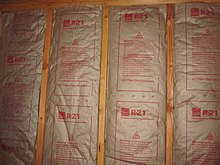
Back قيمة مقاومة حرارية Arabic Wärmedurchgangskoeffizient German Valor R (aislamiento) Spanish ആർ-വാല്യു (ഇൻസുലേഷൻ) Malayalam Valor R Portuguese Сопротивление теплопередаче ограждающих конструкций Russian Giá trị R (cách nhiệt) Vietnamese
This article needs additional citations for verification. (January 2024) |

In the context of construction,[2] the R-value is a measure of how well a two-dimensional barrier, such as a layer of insulation, a window or a complete wall or ceiling, resists the conductive[3] flow of heat. R-value is the temperature difference per unit of heat flux needed to sustain one unit of heat flux between the warmer surface and colder surface of a barrier under steady-state conditions. The measure is therefore equally relevant for lowering energy bills for heating in the winter, for cooling in the summer, and for general comfort.
The R-value is the building industry term[2] for thermal resistance "per unit area."[4] It is sometimes denoted RSI-value if the SI units are used.[5] An R-value can be given for a material (e.g. for polyethylene foam), or for an assembly of materials (e.g. a wall or a window). In the case of materials, it is often expressed in terms of R-value per metre. R-values are additive for layers of materials, and the higher the R-value the better the performance.
The U-factor or U-value is the overall heat transfer coefficient and can be found by taking the inverse of the R-value. It is a property that describes how well building elements conduct heat per unit area across a temperature gradient. [6] The elements are commonly assemblies of many layers of materials, such as those that make up the building envelope. It is expressed in watts per square metre kelvin: W/(m2⋅K). The higher the U-value, the lower the ability of the building envelope to resist heat transfer. A low U-value, or conversely a high R-Value usually indicates high levels of insulation. They are useful as it is a way of predicting the composite behaviour of an entire building element rather than relying on the properties of individual materials.
- ^ United States Department of Energy, Faced fibreglass batt insulation can be stapled to the stud faces or slightly inset, but avoid compressing the batts, United States Department of Energy, retrieved 5 February 2018
- ^ a b Ellis, Wayne (1988). "Appendix: Terminology update: Symbols mean specific terms". In Strehlow, Richard Alan (ed.). Standardization of Technical Terminology: Principles and Practices. Vol. Second. Philadelphia, PA: ASTM. p. 97. ISBN 0-8031-1183-5.
- ^ Rabl, Ari; Curtiss, Peter (2005). "9.6 Principles of Load Calculations". In Kreith, Frank; Goswami, D. Yogi (eds.). CRC Handbook of Mechanical Engineering (Second ed.). Boca Raton, FL: CRC Press. ISBN 0-8493-0866-6.
- ^ Cite error: The named reference
Rathorewas invoked but never defined (see the help page). - ^ Cite error: The named reference
Dictionary Weightswas invoked but never defined (see the help page). - ^ Cite error: The named reference
U-Value Measurement Case Studywas invoked but never defined (see the help page).
© MMXXIII Rich X Search. We shall prevail. All rights reserved. Rich X Search